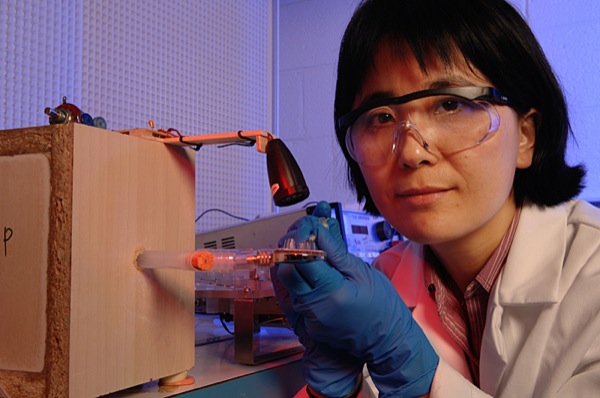
Promising nanotechnology
Nanotechnology for drug delivery shows promise in treatment of pediatric leukemia
8:33 a.m., Dec. 4, 2012--Nanotechnology developed by Delaware scientists could potentially deliver chemotherapy to children in a way that attacks cancer cells without harming healthy cells, greatly reducing side effects.
The work, conducted by researchers in the University of Delaware's Department of Materials Science and Engineering and Nemours Center for Childhood Cancer Research, was published this month in the journal Molecular Pharmaceutics.
Research Stories
Chronic wounds
Prof. Heck's legacy
To date, nanoparticle-based drug delivery approaches have been poorly developed for the treatment of childhood leukemia, which comprises 30 percent of childhood cancers. In the Nemours study, encapsulated dexamethasone (“dex”) delivered to pre-clinical mouse models with leukemia significantly improved quality of life and survival compared to the control receiving the unencapsulated drug.
Acute lymphoblastic leukemia (ALL) is the most common form of pediatric leukemia. Although 5-year survival rates for ALL approach 90 percent with available chemotherapy treatments, the harmful side effects of the drugs, including secondary cancers and fertility, cognitive, hearing and developmental problems, present a significant concern for survivors and their families. Dex is one of the most commonly used drugs to treat childhood leukemia and long-term systemic exposure to dex causes considerable side effects.
Studies conducted by the lead author A.K. Rajasekaran, director and head of the Membrane Biology Laboratory, and his team at Nemours, in collaboration with Xinqiao Jia, associate professor of materials science and engineering and biomedical engineering, and her team at UD, used polymeric nanoparticles containing chemotherapeutic agents to ensure controlled delivery of drugs to cancer cells in preclinical models.
“There are currently seven or eight drugs that are used for chemotherapy to treat leukemia in children,” said Rajasekaran. “They are all toxic and do their job by killing rapidly dividing cells.”
However, he explained, these drugs don’t differentiate cancer cells from other, healthy cells. “The good news is that these drugs are 80-90 percent effective in curing leukemia. The bad news is that many chemotherapeutic treatments cause severe side effects, especially in children.”
He posits that it will take researchers hundreds of millions of dollars and many years to find better alternative drug treatments.
In the interim, scientists like Rajasekaran and his colleagues are working on novel ways to deliver existing and affordable drugs to children.
“Our polymer synthesis and particle engineering are guided by the clinical need for reducing the side effects of cancer drugs,” commented Jia.
Vinu Krishnan, the first author of the study and a UD chemical engineering and materials science and engineering graduate student, said, “I am very excited about the results and look forward to taking this to the next level and introducing this approach for the clinical treatment of childhood leukemia”. Other UD students in the Jia group contributing to this work include Xian Xu and Xiaowei Yang.
To date, advances in nanotechnology have been primarily concentrated around adult cancers. Nanotechnology involves the use of encapsulated particles of drugs that go into the core of the cell. The nanoparticles stick only to the cancer cells and destroy them by delivering the drug precisely, without detecting or harming the normal cells.
In preclinical models of leukemia, Rajasekaran and his team were able to improve survival and quality of life via nanotechnology. Encapsulating the drug uses one third of the typical dose, with good treatment results and no discernible side effects. In addition, subjects that received the drugs delivered via nanoparticles survived longer than those that received the drug administered in the traditional way.
About project support
This work is supported by National Institutes of Health (RO1 DK56216, P20RR016458, P20 RR017716), Delaware Health Sciences Alliance, Andrew McDonough B+ Foundation, Caitlin Robb Foundation, Kids Runway for Research, Sones Brothers, Nemours Foundation and funds from the University of Delaware.








